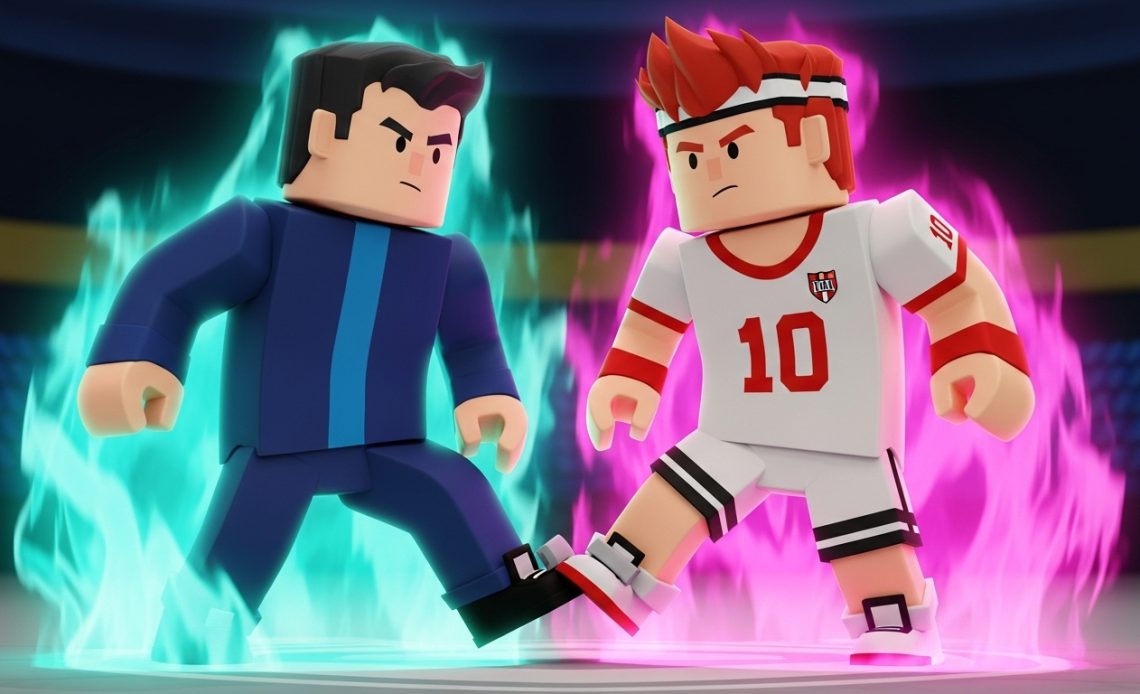
To go ahead of your opponents in soccer, you need to be creative and have good technique. Fans and players alike are fascinated by the “ankle locking” or “ankle breaker” move. This move, which became popular in Blue Lock: Rivals, is now a sign of superior dribbling and offensive power. In this post, we’ll look closely at the ankle locking, including how it works, why it’s important in Blue Lock: Rivals, and how players may learn it to get an edge on the field.
What does an Ankle Lock do in Blue Lock: Rivals?
In Blue Lock, the “ankle lock” or “ankle breaker” Rivals is a way for an attacking player to get around a defender and make room for a shot or a pass. The goal of this technique is to make the defender lose their equilibrium, which usually means they fall or lose their balance. As a result, the dribbler can quickly move toward the goal, which gives them a chance to score or help.
People often think of this action as a quick, rapid change in direction. It uses surprise and deceit to catch the defense off guard. It’s not only about speed or strength when you use the ankle locking; you also need to know when to use it, how to use it, and where the defender is and what they’re doing.
It is an advanced move, but if you learn it, it can change the game in tight scenarios where getting past a defender might make the difference between missing a chance and scoring.
How the Ankle Lock Works
It’s important to break down the main parts of the ankle locking so you can learn how to achieve it. People often say that the ankle lock is a mix of different dribbling moves. It takes exquisite timing, rapid footwork, and precise control over the ball. This is how the method works:
1. Setting up: Getting close to the Defender
The ankle lock starts when the player with the ball gets close to the defender. This is a very important time for the player to figure out where the defense is standing and how they are positioned. At this point, the attacker should pay attention to the defender’s body language and movement while keeping a steady pace.
To start the ankle lock, you need to make it look like the ball is going somewhere. Most defenders think that the attacker would either try to dribble straight ahead or make a simple pass. The ankle lock uses this predictability to get the defender ready for a move that doesn’t happen.
2. The Fake Movement: The First Step
The dribbler makes the defender think they are heading one way by quickly changing direction. Then, with a quick and subtle move, they change course to the other side. Most of the time, this is done with a rapid cut with the inside or outside of the foot, occasionally with a fake to make the defender’s weight go in the incorrect direction.
The fake movement is the most important part here. Before the ankle lock can be used, the defender needs to be sure that the attacker is going in one direction. The faster and more believable the fake, the more likely the defender will lose their balance and stability, which will let the attacker go forward.
3. The Ankle Lock: Getting past the guard
The ankle lock is done when the defender is off balance. In this stage of the move, the player uses a rapid, sharp motion of the ball to abruptly change its direction, taking advantage of the defender’s brief moment of confusion.
The ankle locking in Blue Lock: Rivals is shown as a quick, powerful technique that makes it hard for defenders to get back on their feet. The dribbler needs to quickly contact the ball with the inside or outside of their foot. This will move the ball away from the defender’s guard and let the player cut around them at the same time.
This play puts the defender in an uncomfortable spot, which makes them lose their balance or misinterpret what the next move should be. This gives the dribbler a great chance to move forward.
4. Explosive Speed: The End
Once the attacker has the ankle locking in place, they need to quickly move into the space that has been made. This is very important since the ankle lock breaks the defender’s guard, but it also gives the attacker a little chance to take advantage of it. In Blue Lock: Rivals, the ankle lock is so strong because it lets you speed up quickly and use the space.
At this time, the defender is often off-balance, which gives the attacker a big advantage in terms of speed and location. The attacker has a clear path to either shoot for the goal or pass to a teammate in a better position because the defender is trying to get back on their feet.
Timing and deception are very important in the ankle lock.
Timing and misdirection are very important for the ankle lock to work. A poorly timed ankle lock or one that doesn’t fool the defense can cause the attacker to fail or even lose the ball.
Timing: The time you have to do the ankle lock is quite short. The ankle lock doesn’t work if the defender knows the fake is coming or can see how the attacker is moving. To do a well-timed ankle lock, you need to have perfect control and understanding of when to do the move based on where the defender is.
Lying: The ankle locking works best when you trick someone. The defender will be taken off guard if the attacker can make them think they are going in one direction before rapidly moving the ball to another. If the fake looks more convincing and the defense changes direction faster, they are more likely to lose their balance and let the attacker through.
Why the Ankle Lock is a Hard Move
There are a few reasons why the ankle lock is thought to be an advanced move:
Skill Level: You need to have good footwork and ball control to make this move. It’s not just about speed; you also need to know how to transfer the ball accurately in tight places and keep track of what the defender is doing.
Risk Factor: The ankle lock is a very dangerous move. If the defense can figure out what the attacker is trying to do or if the timing is wrong, the player can easily lose the ball. The attacker also runs the risk of going too far in one direction and losing their own balance.
Situational Awareness: To do the ankle lock well, players need to be very aware of how the game is going and how the defender is acting. A skilled player can read the defender’s body language and adjust to their actions, which gives them the perfect chance to attack.
Speed and accuracy: You need to do the ankle lock quickly and accurately. The attacker has only a split second to trick the defender, make the move, and then take advantage of the opening that was created. This calls for fast thinking, good footwork, and strong acceleration.
How to Get Good at the Ankle Lock

You need to practice and be patient to get good at the ankle locking. If you want to incorporate this approach to your game, here are some tips:
Improve Ball Control: Players need to be able to control the ball well in order to use the ankle lock correctly. To get good at this skill, you need to practice dribbling with both feet and getting better at feeling things.
Practice changing directions quickly: The ankle lock needs you to change directions quickly. Players will get better at faking a movement and changing direction quickly if they practice drills that focus on sharp cuts and rapid pivots.
Learn to Read the Defender: To do the ankle locking correctly, you need to know how the defender moves and where they are. Players should practice closely studying defenders to figure out how they will respond and when to make their move.
Speed and Agility Training: After the ankle lock is done, the player needs to be able to speed up rapidly to take advantage of the opening. Players can learn how to use the space created by the ankle lock by training for speed and agility.
The greatest method to learn how to do the ankle lock is to use it in real games. Practice the move in training first, and then use it in matches little by little. As players get more confident, they will get better at figuring out what’s going on in the game and doing the move at the proper time.
The Ankle Lock: A Game-Changer in Blue Lock: Rivals, in Conclusion
The ankle locking is a fun and useful way to dribble that lets players get past the defense and set up scoring chances. In Blue Lock: Rivals, this technique shows that you are skilled and creative, and it requires precision, timing, and quick thinking. The ankle lock is a risky move, but if players learn how to use it well, they can get a big advantage by outsmarting defenders and making room for a shot or pass.
Players can use the ankle lock in their offense by combining ball control, footwork, and awareness of their surroundings. This is an important ability for any player who wants to improve their dribbling and get past the toughest defenses, whether they’re playing Blue Lock: Rivals or real-life soccer. With time and effort, the ankle lock can become a powerful tool for a player.


